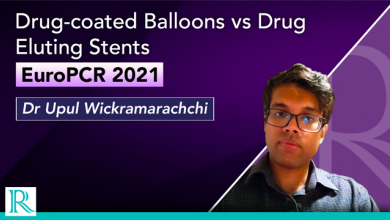Search results
Author(s):
Gregg Stone
Added:
3 years ago
Drug-eluting stents (DES) are the standard percutaneous treatment strategy in patients with coronary artery disease (CAD). Their use has further reduced the incidence of restenosis and repeatrevascularisation in single vessel de novo disease. These stents have bioactive coatings that, through a complex mechanism, allow the release of various antiinflammatory and anti-proliferative drugs at high…
View more
Author(s):
Kamal Chitkara
,
Anthony H Gershlick
Added:
3 years ago
First-generation Stents
Since drug-eluting stents (DES) received the CE mark in 2002 and the US Food and Drug Administration (FDA) approved the first DES in 2003, there has been a significant increase in the use of these devices. The advent of DES has revolutionised the field of interventional cardiology by having a major impact on patient care through their efficacy in reducing the need for…
View more
Author(s):
Upul Wickramarachchi
Added:
2 years ago
In this video, Dr Upul Wickramarachchi (Norfolk and Norwich University Hospital NHS Foundation Trust, Norwich, UK) discusses the clinical outcomes of drug-coated balloon angioplasty treated patients versus drug-eluting stent treated patients for de novo coronary artery disease in all vessel sizes.
Questions
1. What question does this study aim to address?
2. What was the design, patient cohort…
View more
Author(s):
Fumiyuki Otsuka
,
Masataka Nakano
,
Saami K Yazdani
,
et al
Added:
3 years ago
Percutaneous coronary interventions (PCI) involving stenting are the most widely performed procedures for the treatment of symptomatic coronary disease.1 Although first-generation sirolimus-eluting stents (SES; Cypher™, Cordis Corp., Miami Lakes, FL) and paclitaxel-eluting stents (PES; Taxus™, Boston Scientific, Natick, MA) have radically reduced restenosis,2,3 complications of late (LST) and…
View more
Author(s):
Didier Carrie
,
Marco Valgimigli
,
Gennaro Sardella
,
et al
Added:
3 years ago
Percutaneous coronary intervention (PCI) involving stenting is routine practice, and involves either bare metal stents (BMS) or drug-eluting stents (DES), which allow controlled release of antiproliferative drugs at the arterial waazll.1 However, the persistence of durable polymers in first-generation DES led to numerous problems including inflammation, delayed arterial healing, aneurysm…
View more
Added:
2 years ago
Dr. Tullio Palmerini is discussing the 1-year & long-term outcomes of the Network Meta-Analysis on Target Lesion Failure with Current Drug-Eluting Stents, sharing his insights from the analysis and its implications to everyday clinical practice.
Key Learning Objectives
To learn about the recently published Network Meta-Analysis on TLF with current DES
To review the role of ultrathin DES in…
View more
Author(s):
Mohammad Sahebjalal
,
Nick Curzen
Added:
3 years ago
Antiplatelet therapy (APT) represents a major cornerstone in the secondary prevention of coronary artery disease, along with modifying patients’ risk factors. Furthermore, it has been clear, since early unsuccessful regimens, including warfarin and dypiridamole with aspirin, that it is APT that stops coronary stents from clotting off and causing stent thrombosis.1,2 Specifically, the requirement…
View more
Author(s):
Corrado Tamburino
,
Davide Capodanno
Added:
3 years ago
Recently, many eminent scientific journals have published long-term follow-up data from both randomised clinical trials (RCTs) and registries of patients treated with percutaneous coronary intervention (PCI) undergoing drug-eluting stent (DES) implantation. In fact, this is the only course of action to address the concerns regarding DES safety that were first raised almost two years ago.1…
View more
Author(s):
Tom Adriaenssens
,
Giovanni J Ughi
,
Jan Dhooge
,
et al
Added:
3 years ago
In the bare metal stent (BMS) era, several intravascular ultrasound(IVUS) studies have validated the strategy of reducing in-stent restenosis rates by a strict adherence to an optimal stent implantation technique, predominantly by avoiding stent underexpansion.1 In a first phase after the introduction of drug-eluting stents(2003), the spectacular reduction in restenosis rates, based on…
View more
Author(s):
James Gilbart
Added:
3 years ago
In coronary artery stents, the coverage of the internal structures with neo-intimal formation has been regarded as a negative development leading to restenosis and loss of luminal space in the blood vessel. However, some coverage of the stent can be beneficial, providing coverage of protrusions in the internal stent structure that may otherwise constitute a thrombotic risk. Recent studies have…
View more













